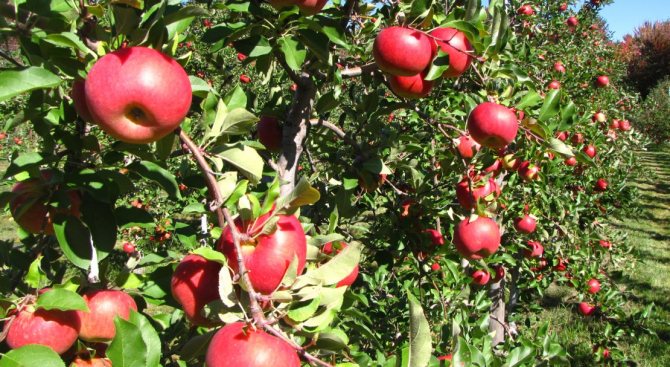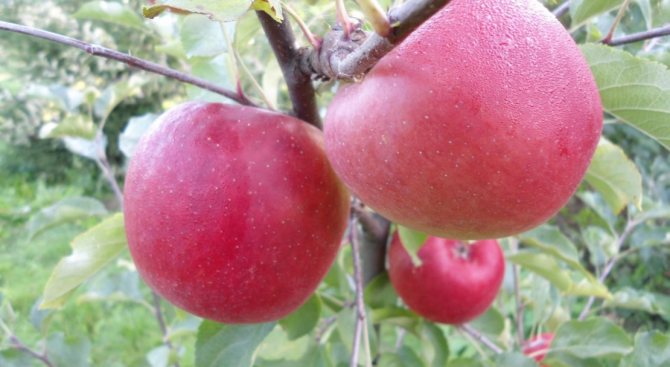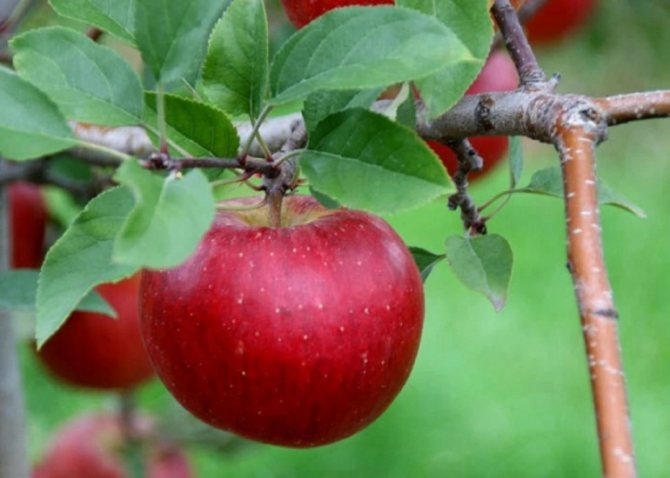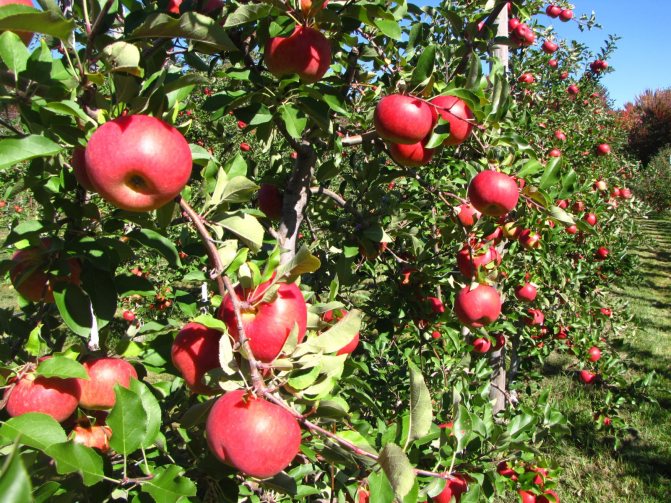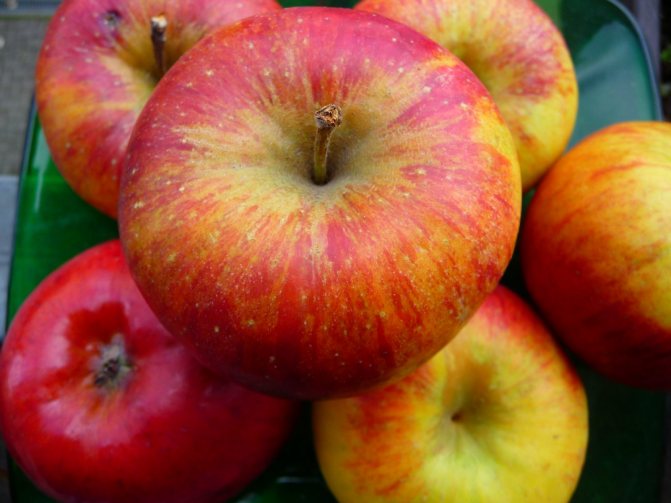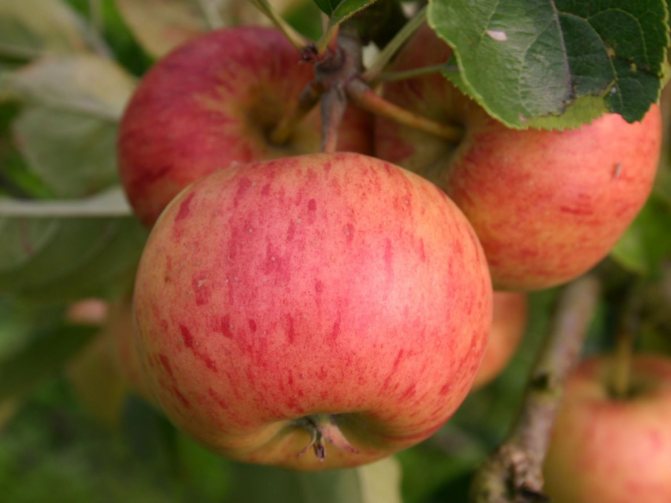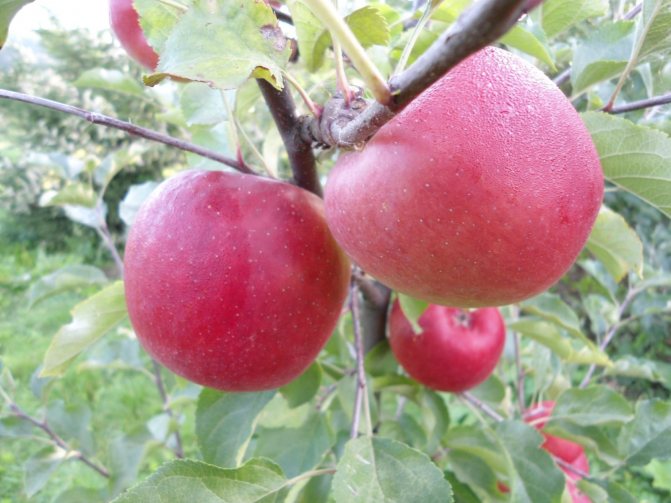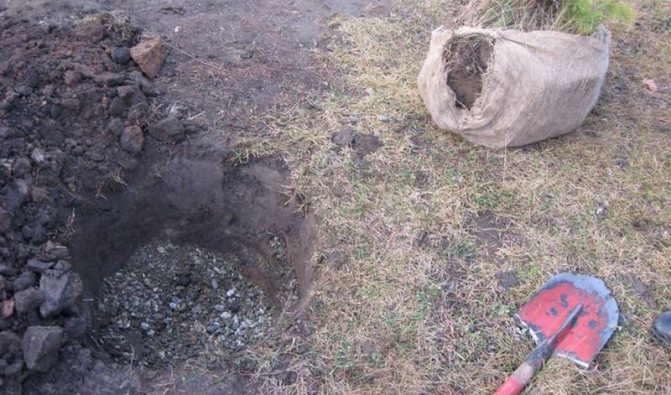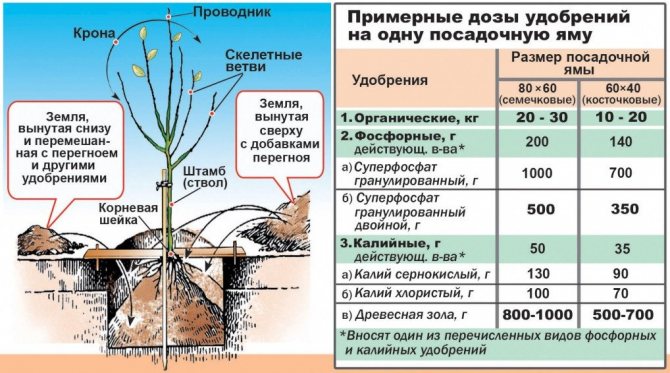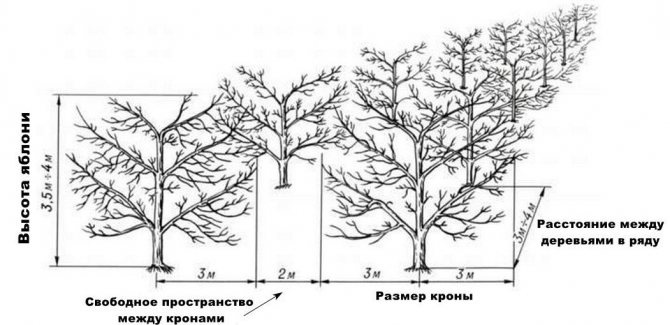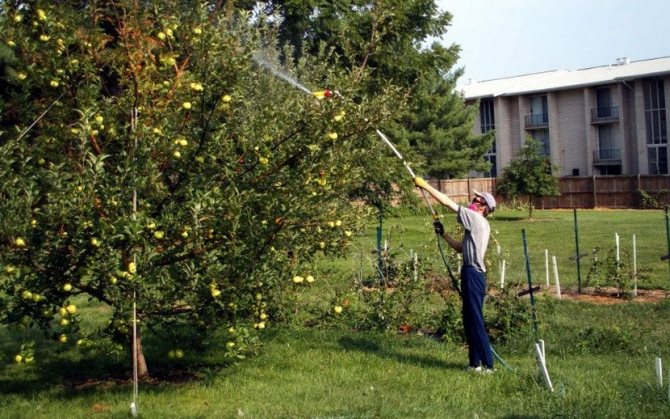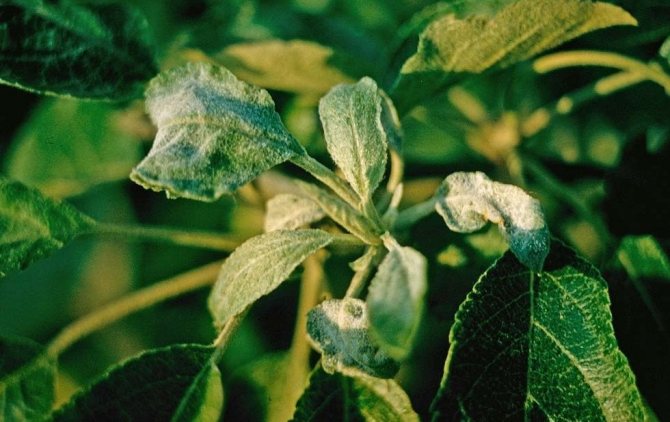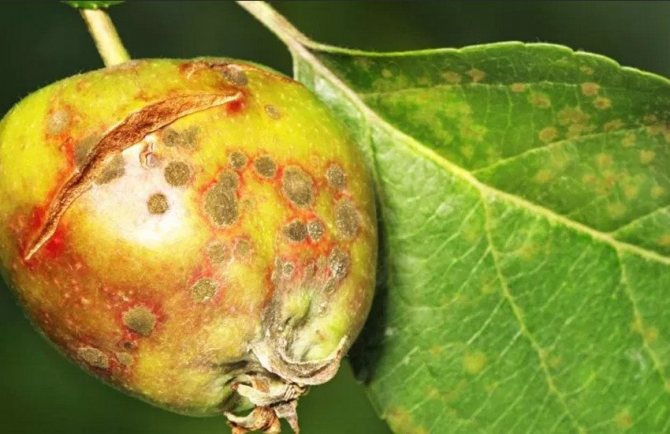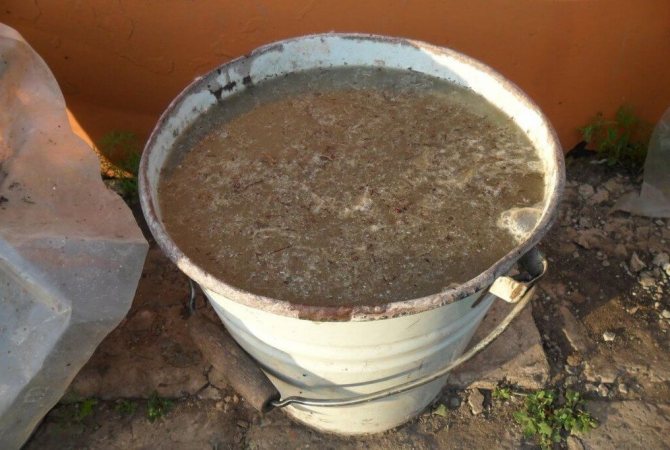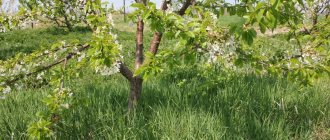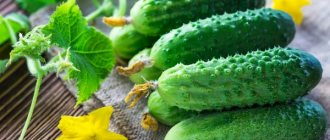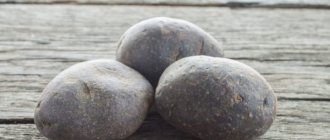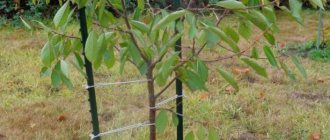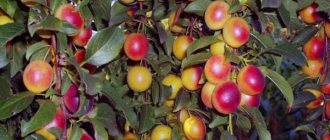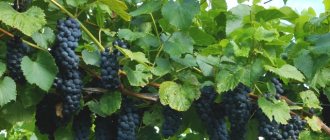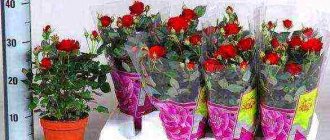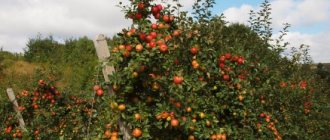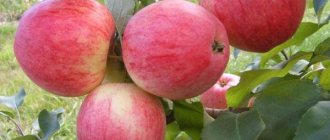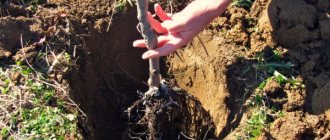On the territory of the Urals, the relief is rather dissected and uniform, unfortunately, is not. Most of the area is occupied by mountains that create climatic barriers. On the western side, the climatic conditions are much milder, but the amount of precipitation is noticeably higher. On the eastern side, the climatic conditions are arid and more severe. Thanks to the above information, various fruit trees have a good survival rate. For the inhabitants of the Urals, this variety of apples with a tasty and healthy harvest was specially bred. Due to its qualities, the Ekrannoe apple tree is widely known throughout the Urals, as well as throughout our country. When selecting this variety of apples for their summer cottage, suburban or personal plot, summer residents need to learn about all the characteristics of the fruit crop, the methods of its correct planting and instructions on agricultural technology in the future.
Apple variety Ekrannoe
Screen is an autumn apple variety obtained at the Sverdlovsk Experimental Gardening Station through pollination of the Yantar variety with a mixture of pollen from Zvezdochka, Gem and Orange. Probably, fertilization occurred from the pollen of the Zvezdochka variety, since the new hybrid clearly absorbed its characteristics. The authorship is assigned to L.A. Kotov. The variety is zoned in the Volga-Vyatka region. It is widespread in the new settlements of the Urals, Middle and South Urals. Also, this apple tree is promising for many other regions.
Trees are medium-sized, fast-growing. The crown is spreading, rounded, medium thickened. The main branches are straight, compactly located, directed obliquely upward, when they leave the trunk, they form an angle with it close to right. The bark on the main branches is smooth and greenish. Trees bear fruit mostly on spears, simple and complex ringlets, starting from 2-year-old wood.

Shoots are brownish-brown in color, thin in thickness, arcuate, fleecy, round in cross-section. The leaves are medium in size, painted in dark green color, they can be round or oval in shape, the top is short-pointed, the edges are serrated. The leaf blade has a matte, finely wrinkled surface with delicate nerves and a rounded base. The petioles are long. Stipules are elongated, crescent-shaped.
The flowers are medium-sized, cupped, white in color, with a slight pinkish tinge; stigmas of pistils are located above the level of anthers or almost equal to them. Unblown buds are creamy in color.
The fruits of the Ekrannoe apple tree are smaller than the average size, the weight of one apple ranges from 65 to 90 grams. Apples are one-dimensional, regular in shape, rounded, slightly flattened, with weakly pronounced wide ribs. Skin with a smooth surface, dry, glossy, covered with a waxy coating. At the time of removal, the main color of the fruit is greenish-yellow, later it becomes light yellow, the integumentary color is pronounced in the form of a continuous blurred blush of pink-red color. A distinctive feature of the variety is a floating funnel, often with an influx on one side in the form of a tubercle, it is small in size, with a slight rustiness. The stalks are short. The saucer is small and wide. The cup is half-open. The sub-cup tube is short, broadly conical in shape. The heart is large, onion.The seed chambers are open. Seeds are small, dark brown in color, ovoid.
The pulp with a creamy shade, dense and fine-grained in structure, prickly, good taste - sweet and sour, very juicy and tender, quite aromatic. Taste qualities of the Ekrannoe apple tree on a 5-point tasting scale are estimated at 4.3 - 4.5 points. According to the chemical composition, the fruits contain: the sum of sugars (10.6%, depending on the place of cultivation, it can reach 15.6%), dry soluble substances (13.2%, the limit is 15.6%), titratable acids (0, 66%, limit - 0.98%), P-active substances / catechins (167.8 mg / 100 g, limit - 320.3 mg / 100 g), ascorbic acid (total 6.16 mg / 100 g).
Fruit ripening occurs in early September. If stored properly, apples can be consumed fresh until January-February, the maximum shelf life does not exceed 150 days. The fruits are also suitable for various types of processing. The transportability of apples is good.
Screen refers to self-infertile varieties, so it will be well pollinated by any other varieties common in the growth zone.
At the time of fruiting, trees enter the 5th year after budding. Flowering and fruiting are characterized by regularity. The yield of the apple tree is high: the average indicator for 6 years is 116 c / ha, the maximum indicator was more than 150-200 c / ha. Winter hardiness is good enough. In general, the variety is unpretentious and disease resistant in care. Only in epiphytotic years, leaves and fruits are moderately affected by scab.
The main advantages of this apple tree are: beautiful and tasty fruits, good yield, the ability to process apples.
Speaking about the disadvantages, one should pay attention to the chemical composition of the fruit - against the background of the optimal ratio of sugars, P-active substances and fruit acids, the proportion of ascorbic acid is extremely low.
additional characteristics
- Medium trees, moderately growing, reach a height of 5-6 m, the crown is spreading, in adult trees - weeping.
- Long branches, arched, dark gray. The lower branches form an acute angle with the trunk, the upper branches form a straight angle.
- Escapes slightly pubescent, straight. Fruit formation is mixed, 2-3 apples on biennial shoots and last year's growths.
- Leaves are medium, ovoid, glossy, the tip of the leaf blade is slightly curled.
- Elongated fruits, oblong-conical, can reach a mass of 120 to 200 g. Skin color is yellowish-green, a brown blush appears in the bright sun. The pulp is greenish, juicy, sweet, having reached consumer ripeness, it acquires a light melon aroma.
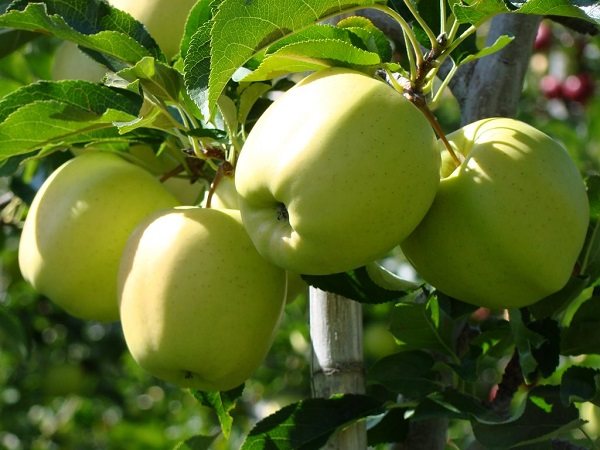

Fruits of the Koraz variety on an apple tree branch up to 120-200 gr.
What species does it belong to?
Screen is a hybrid variety of apples of the autumn harvest, tolerating winter well, unpretentious, moderately resistant to diseases, high yields.
The hybrid was obtained at the breeding station of Sverdlovsk, and is popular among gardeners in the Urals and Urals. Approved for distribution in the East Siberian region, included in the State Register for the Volga-Vyatka region. Promising for distribution over a wider area.
The variety is self-fertile, however, Ekranny is perfectly pollinated by other varieties growing in the same zone.
Apples can be processed in any way, they can be easily transported. The fruits can be stored for up to 5 months without losing their taste. The best storage method is lying in the cellar, on the balcony or in the refrigerator; when placed in a vegetable pit in a sealed form, rotting begins from the inside.
Testimonials
Both adults and children love them. Trees are unpretentious to care for, but they love watering. I also do pruning and feeding every year. The harvest is good.
My family is very happy, all the guests have only positive feedback. "
In addition, they are stored throughout the winter. I have an old tree on my site, but it still bears fruit every year, pleases with large and tasty fruits. I recommend this apple variety to everyone. "


Caring for the Korah apple tree, guarantees the annual harvest.
Our tree is old, sometimes it gets sick with scab, especially when it's rainy summer. But we cut and feed it regularly, and it pays off with a great harvest that we harvest every year. "
Description of the variety Screen
The photo shows a branch of an apple tree of the Ekrannoe variety and a description is given below.
Read also: The most common diseases of apple trees and methods of their treatment (with photo)


- The Screen variety tree grows medium-sized (about 3 meters) and grows quickly.
- The shape of the crown is round, spreading, of medium density.
- Shoots are round, thin, curved, in the lower part they grow almost perpendicular to the trunk, curving upwards. The thickness of the shoots is small, the cross section is rounded, the bark on them is smooth, brownish-brown. The main branches are covered with greenish bark.
- The tree is moderately leafy, the leaf is medium-sized, finely wrinkled, the color is dark green. The shape of the leaves is round or oval, with elongated petioles, at the top of the leaf there is a short sharpening, along the edge there are serrated teeth.
- The buds are creamy, the flowers are medium-sized, white-pinkish, bowl-shaped.
- The weight of the fruit reaches 90 g, sometimes even 100 g. Formed mainly on the spears and ringlets of biennials. Apples are distinguished by a regular rounded shape, with an unexpressed funnel, often a one-sided influx on it. The fruits are covered with a smooth glossy rind, there is a waxy bloom. The main color is light greenish, a pronounced reddish-pink or purple blush is blurred over the entire surface.
- The pulp is light creamy, high density and juiciness, prickly type, with fine grain, tender. Taste indicators are good, taste is sour-sweet. The aroma is moderately pronounced, pleasant.
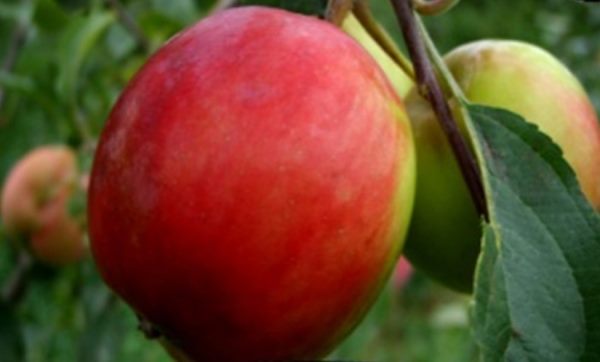

- sugar - 10.6%, maybe up to 15.6%;
- fruit acids - 0.66-0.98%;
- catechins - 167.8-320.3 mg per 100 g;
- ascorbic acid - reduced capacity: 6.16 mg per 100 g.
Photo
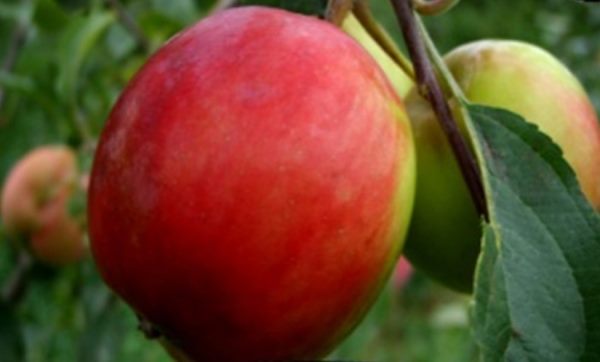

The chemical composition of apples Screen:
- sugar - 10.6%, maybe up to 15.6%;
- fruit acids - 0.66-0.98%;
- catechins - 167.8-320.3 mg per 100 g;
- ascorbic acid - reduced capacity: 6.16 mg per 100 g.
Region of natural growth
The screen was launched with the aim of distribution in the Urals, in the same region, and gained widespread popularity. However, due to its unpretentiousness to soil and climatic conditions, this variety is easily adaptable to other horticultural regions.
Moreover, bred specifically for the harsh climatic conditions of the Middle Urals, in regions with a milder climate this variety takes root better, grows better and bears fruit. Apple trees do not require special conditions, they can be grafted onto other varieties, or grown in a standard way (that is, as individual trees).
Cultivation in certain regions
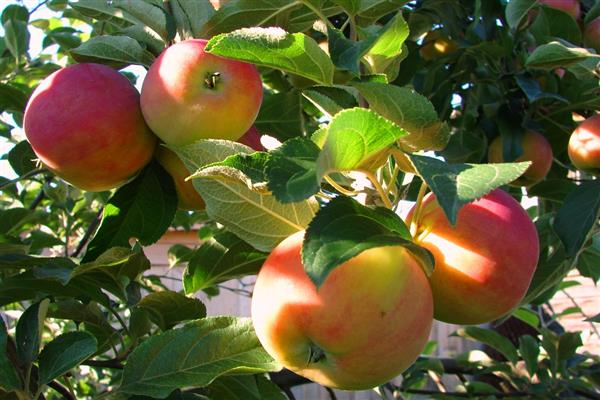

For the good development of the apple tree, it is necessary to have information about the distinctive features of cultivation for a particular region separately.
The middle strip of our country
This variety of apples has all the indicators of varieties for cultivation in the territory of the Moscow region and the middle zone of our country.
For good survival of the planting material in a certain region, the apple tree is planted in the fall. The optimal time for this is the end of the first autumn month.
At this time of planting, the planting material manages to release the roots before the arrival of the first cold weather.
Siberia
Winter seasons that do not have a sufficient amount of snow in Siberia affect the growth and development of the fruit tree. To avoid freezing of the apple tree in a certain region, summer residents recommend preparing the tree before winter. To do this in the autumn season:
- the soil at the trunk is covered with a layer of mulch.
- whitewash the trunk.
- cover the apple tree with special materials.
Important! To avoid attacks of parasites near the tree, various baits are installed to distract from the apple tree.
Ural
Initially, the Ekrannoe apple tree was created for the Urals. The fruit tree is well adapted to the climate of the region.
However, in order for the apple tree to grow a couple of centimeters every year, the accelerated design of fruit branches and a high level of resistance to cold and frost in this region, the apple tree requires the necessary number of nutrients and liquid.
For this, in the first twelve months, the tree is constantly moistened. Twenty-four years after planting, apple fertilizers begin to be applied.
Yield


From one tree you can get up to 64 kg of apples, on average - 20 kg.
54 quintals were received per hectare in the years of testing (this is 6.4 quintals more than Antonovka's), over 6 years of cultivation this figure increased to 116 quintals.
Fruiting occurs in the third to fifth year after the scion has taken root and in the sixth to seventh - after planting the seedling. The crop is harvested in late August or early September, the indicator of fruit ripeness is the dark brown color of the seeds.
Apple tree Korey on undersized rootstock
Since the middle of the last century, fruit-producing countries have grown apple trees only on undersized rootstocks - dwarf and semi-dwarf. Such a stock retains the properties of the mother plant and, at the same time, has a number of advantages:
- Higher productivity;
- Early fruiting - bears fruit for 2-3 years after planting;
- Thanks to the dense planting of trees, it saves space in the garden;
- You can grow trees in places with a close occurrence of groundwater;
- It is characterized by larger and more tasty fruits.
Dwarf lifespan - 15-20 years, but during this time they will give much more fruit than vigorous trees.
By growing Korah on a low-growing rootstock, you can easily take care of the tree and harvest delicious apples.
Advice! When reclaiming a new plot with depleted, barren land, cultivate it a few years before planting an orchard. To do this, nitrogen fertilizers (preferably organic) should be applied to the soil and dug up.
Planting and leaving
The screen is not picky about soil and climate, the conditions for planting or grafting are determined by standard rules. The difference in conditions can only affect the chemical composition of the fruit.
The time of planting a seedling is from spring to autumn. In the spring and summer, cloudy days with low air temperatures are better suited for planting. If the seedling has already bloomed, you need to cut off all the flowers so that the plant spends maximum effort on survival. Still, it is best to plant a tree in the middle of autumn - then the full growth of the tree will begin next year.
After planting, the seedling needs abundant watering.
Since the variety is self-fertile, it is necessary to ensure the possibility of pollination with other varieties. There are no special requirements, it is enough for apple trees of other varieties to grow nearby, - Ekrannoe is perfectly pollinated.
Varieties
Semi-culture
In the northern parts of our country, in which the temperature regime drops to minus forty-seven degrees Celsius during the winter season, summer residents inoculate this variety to uncultivated ranetki. Because of these rootstocks, the fruit tree receives less frost damage and begins the harvesting process faster.
The tree grows no more than two hundred centimeters up at the age, the crown is spreading. The first fruits can be harvested when they reach the age of three after grafting. The crop of good appearance is small, most often the mass of one fruit reaches fifty - seventy grams.
Stamp
To save space in the summer cottage, the fruit tree is grafted into columnar varieties.
On these rootstocks, the apple tree has a strong column-type stem, which is overgrown with ringlet. The crown is quite rare, no shaping is required.
The stem tree usually begins harvesting when it reaches one year of age. The first fruits are usually in small quantities, but their number increases over the years.
Diseases and pests


Ekrannoe apple trees are characterized by resistance to scab.
Individual cases of the disease are observed in years with high humidity and epiphytoty (epidemic spread of infectious plant diseases), that is, when there is a general increase in the incidence.
If the year turned out to be wet, special treatment for scab, powdery mildew is required. Resistance to pests is also average; with large volumes of infestation, the tree will need processing.
The screen received high recommendations from gardeners for its high taste and good yield, winter hardiness and unpretentiousness. Delicious, ruddy apples of this variety are stored for a long time and can even decorate a New Year's table. In addition, they perfectly tolerate transportation. Preparations for the winter from these apples, including juices, are quite good.
Features of ripening and fruiting
There are features of fruiting that are associated with the beginning and collection of fruits.
The beginning of fruiting
The tree is not early and bears fruit only 5-6 years after planting.
Flowering time
The late variety begins to bloom in the second half of May, and sometimes even at the end.
Fruit ripening
Winter apples are harvested in late September or early October, depending on the type of climate. But then they still do not fully gain their taste. Consumer maturity occurs in a month.
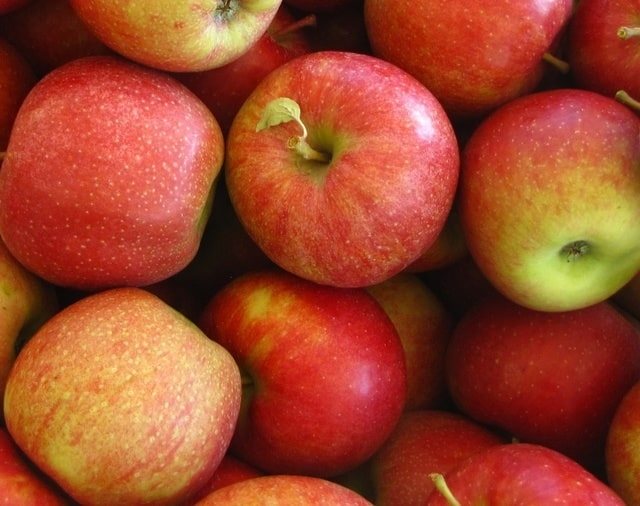

Apple fruits Topaz.
Harvest storage
If the correct humidity and temperature conditions are created, which is 90% and 0 ° C, respectively, apples are stored without loss of quality and weight for more than six months.
Breeding history
The Ekrannoe apple-tree is a hybrid variety of autumn ripening. It was obtained in 2002 as a result of pollination of the Yantar variety with pollen from the Samotsvet, Orange and Zvezdochka varieties.
The authorship and the patent for the hybrid belong to L.A. Kotov, the development was carried out at the Sverdlovsk station.
Read also: Apple jam - a recipe with a photo step by step
Due to its characteristics, the variety quickly spreads in the gardens of the Urals and surrounding areas.
Bred for harsh climates, with good winter hardiness, it has the prospect of growing both in regions with cold winters and in mild southern climates.
Pollinators
Topaz is one of the self-fertile varieties of apple trees, therefore, pollinators that bloom with it at the same time will be required to form a crop. And there are quite a few of them for our hero. The choice can be made from the following varieties: Idared, Florina, Raika, Golden Delicious, Discovery, Breburn, Angold, Goldstar, Resista, Rubin step, Retina, Ruby Duki, Gloucester, Rubinola, Revena, Saturn.
Biological features of the variety
The Apple tree "Ekrannoe" received good reviews among amateur gardeners and farmers - let's take a closer look at its description and photos, as well as the quality of the culture.
Description of the tree
The tree is distinguished by its fast growth, smooth greenish bark, brown thin shoots. The crown is round, spreading, with straight, not too densely growing branches, the growth of branches is directed upward from the trunk.
The foliage is dark green, in the form of a wide oval, with a jagged edge. Leaves are matte, located on long petioles. The entire leaf blade is covered with thin (like a mesh) veins with a pronounced central vein, clearly dividing the leaf in half lengthwise.
Description of fruits
The fruits of an apple tree are even, rounded, of medium size: weight ranges from 60 to 100 grams. The glossy skin is covered with a slight touch of wax. During ripeness, the fruits turn yellow-green in color, with a bright pink-red blush.A distinctive feature of the apple is a swollen funnel with a brown tubercle.
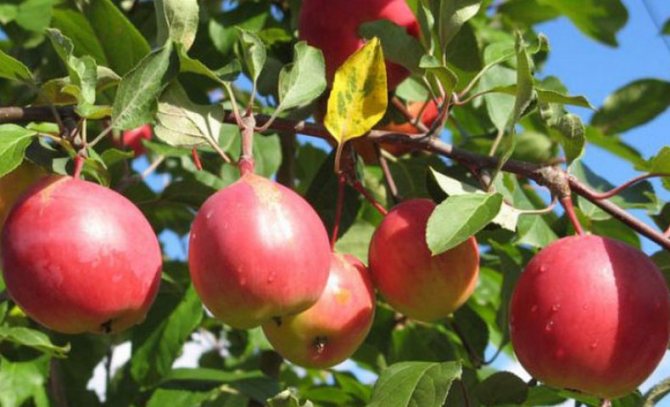

The pulp is creamy, dense, juicy, fine-grained. The apples taste sweet and sour with a pleasant aroma. In a large heart there are open seed chambers, the seeds are dark brown, small.
Ekrannoe is a self-fertile variety, it is perfectly pollinated by other apple varieties growing next to it. Suitable pollinators will be the same autumn varieties: "Orlovskoe striped", "Skala", "Uspenskoe", "Solnyshko".
Ripening period
The apple tree begins to bear fruit in the fifth year of development, fruiting is regular. The fruits ripen in August-September. You can check the ripeness by breaking the fruit in half: if the seed is dark brown, it means that the apple is ripe.
Yield
Yield indicators are quite high - on average, up to 20 kg of apples. From an adult tree that has been bearing fruit for several years, up to 65 kg are harvested. During the cultivation of the variety in farms, over one hundred centners of fruit were harvested per hectare.
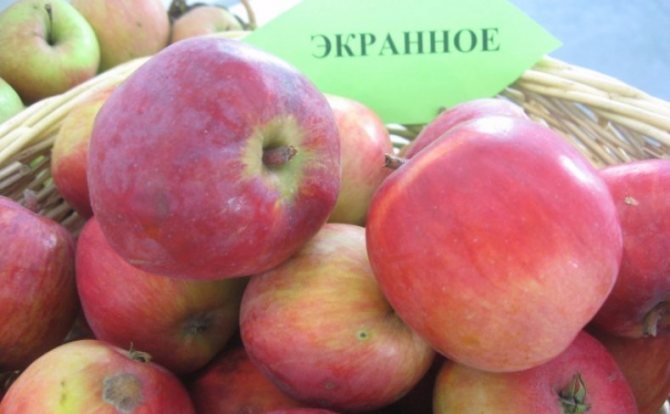

Winter hardiness
"Screen" is resistant to cold weather, painlessly tolerates sudden temperature changes and recurrent frosts.
Application
The fruits keep well, but if they are allowed to overripe, the shelf life will be reduced. The harvested crop is stored in a cold place (cellar, unheated balcony). Thus, it can be consumed fresh in winter: shelf life is up to five months.
Fruits are suitable for processing: juices, compotes, jams and preserves are made from them.
Tips & Tricks
Many gardeners recommend following a few simple tips.
- Do not neglect pruning, because the crown can quickly thicken.
- Although the wood is resistant to cold weather, prevention and insulation will never hurt.
- It is important to whitewash the trees for the winter so that young shoots do not burn.
- If you spray an apple tree with copper-containing preparations in the spring, then you can not be afraid of powdery mildew. But it's better to check the state of the branches.
Apple Topaz is not fastidious and capricious. Therefore, standard care procedures are not difficult.
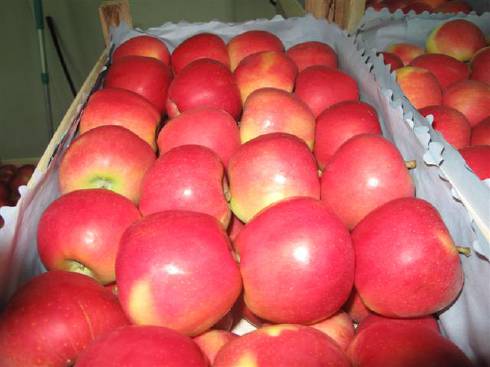

Storage of the harvest of Topaz apples.
Planting apple seedlings "Ekrannoe"
There are no difficulties in how to plant an apple tree. Before the procedure, you need to inspect the seedling, cut off damaged shoots and roots, process the sections with crushed coal. The main requirement for a seedling is a healthy root system and dormant buds.
Optimal timing
The apple tree is planted in spring on cloudy and cool days. But the best time is autumn, in this case the tree will begin to grow and develop fully next year.
Seat selection
The culture is unpretentious to the composition of the soil, but it is better if it is fertile and with a neutral reaction. Bad neighborhood - close-growing old trees with an extensive root system, they will deprive the seedling of food and moisture, and close it from sunlight. The place must be chosen open, not subject to drafts.
Step-by-step planting process
Autumn planting. A couple of months before planting, they dig a hole so that the soil subsides. The size of the hole is approximately 50x50 cm, focus on the length of the roots. The best time to plant in autumn is after leaf fall. During this period, the seedling will begin to actively grow the root system, and the aboveground part will be dormant until spring.
In order not to wake up dormant buds, you should not put fertilizer on the bottom of the pit. To support the seedling, you need to drive a peg one and a half meters long into the bottom of the pit. The roots of a young tree are straightened, placed along the bottom of the hole and covered with earth. At the same time, the root collar is flush with the edge of the pit, the soil is carefully tamped.
The seedling is tied to a peg and watered, even if it rains. After watering, the land can sink significantly: you should also add soil.Closer to winter, mineral fertilizers are scattered over the surface of the soil - they will lie under the snow until spring, and then seep to the roots with melt water, nourishing them. Spring planting differs in that fertilizer must be placed in the planting hole if wood ash is added to the acidic soil. As a fertilizer, you can use the "Universal Ideal": it is mixed with fertile soil, put on the bottom of the pit and a bucket of water is poured there.
The seedling is lowered to the bottom, spreading the roots, covered with soil. After watering is carried out - when the soil subsides, add more. The root collar of the seedling is flush with the surface. To protect the tree from the wind, pegs are driven in a circle.
Magnificent apples with a pleasant aroma will give you the variety Korey
Apple trees are the most common fruit trees.
With proper care and adherence to planting rules, it can delight with a rich harvest.
The varieties differ not only in taste and appearance, but also in the cultivation characteristics.
…
The apple variety Korey belongs to the varieties of the late winter period.
Korah is attractive because the fruits have a long shelf life - without changes in taste, they can lie until June, stored in boxes, pre-lined with paper.
Pollination
This variety requires pollination with apple trees of other varieties for fruiting, suitable: Golden Delicious, Simirenko, Kuban or Idared.
Description of the variety Korey
The appearance of the apple tree plays an important role, each variety has special characteristics.
Kore trees grow to medium size.
The crown grows sprawling, and mostly becomes weeping over time.
The branches in the lower tiers form an acute angle with the trunk, and in the upper tiers they form a straight angle.
Long, arched. The bark of the tree is dark gray.
Shoots are straight in shape, thick, have weak pubescence. Leaves are oval, slightly tapering towards the top, have a dark green color, smooth to the touch.
The flower is usually medium in size, saucer-shaped, and pink in color.
The fruits are often medium-sized.
In shape, they resemble a truncated oblong cone, expanding towards the base, around there are clearly outlined tubercles of the ribs.
The fruit cover is thick, flattened, with a noticeably large number of small dots, usually white, less often brownish.
The color of the apples is pale green.
When grown under good light, the fruits acquire an orange blush.
When ripe, the apples acquire a rich yellow color and fragrant aroma.
The pulp of the fruit is greenish in color, juicy, the taste may be absent when taken, or it may be sweetish. Ripening, the aroma acquires perceptible melon notes. The fruits grow in groups of two or three apples.
Photo
Breeding history
This variety was obtained by hybridization of two varieties. Comes from the Golden Delicious variety, which was pollinated by the Indo variety.
This variety has acquired the best taste, as well as the size of the fruit is larger than the "parents".
Region of natural growth
The usual growing areas are the North Caucasian region.
It is also zoned in the southern regions - Rostov region, Krasnodar region and Dagestan.
Apple trees of the following varieties are also suitable for planting in these regions: Prima, Yuzhny.
Yield
This apple variety is considered early-growing - it begins to bear fruit already in the fifth year. Fruiting is annual.
It has a high yield, in some cases - up to 600 centners can be harvested from one hectare, usually up to 300.
You can remove the fruits at the end of September and until the beginning of October.
Storage of fruits is possible until June. Apples can be consumed both fresh and processed.
Good transportability, high quality of fruit marketability.
The varieties of apple trees are distinguished by a high yield: Antonovka Dessertnaya, Gala, Winter Grushovka, Papirovka, Kuibyshevskoe, Yablochny Spas, Pepinchik's Daughter, Antey, Lyubava, Yandykovskoe, Welsey, Stroyevskoe, Sokolovskoe.
This variety is considered one of the best late winter varieties if care has been taken in full.
When planting, it is important to choose a favorable place for the apple tree.
Since this variety requires pollination with apple trees of other varieties, they, of course, should be planted nearby on the site.
Then a high and high-quality yield will be guaranteed.
The first step is to prepare the soil for the seedling. A hole is dug, preferably a month before the intended planting, this is necessary so that during this time the soil is sufficiently compacted.
Usually, a hole is dug up to 60 centimeters deep and a little over a meter in diameter.
Next, the pit is buried with the top layer mixed with fertilizers, the dug bottom layer is scattered around the perimeter.
You can start planting seedlings in autumn and spring.
However, the weather should already be consistently warm.
The root collar of the tree should be several centimeters above the soil level when planting, then the roots are spread over the surface and sprinkled with soil.
After planting, the seedling must be watered with three buckets of water, this will help the soil to adhere more tightly to the root system.
TIP: If other crops have sprouted earlier in the place where you decided to plant the apple tree, then you should not add fertilizer to the topsoil in order to avoid an abundance that can cause damage.
Next to the seedling, you need to install a wooden peg, to which the tree is tied with a loop-eight so that it does not rub in the wind. When cold weather sets in, the soil around the tree is fertilized with humus.
If it is not enough to take good care of Korea, then the taste of the fruit will noticeably deteriorate, the yield will decrease.
The main care for an apple tree is pruning. Shaping pruning should be done annually.
If you follow this rule, the tree will begin to bear fruit earlier, the yield will be increased, and the apple tree will be more durable.
The first shaping pruning should be in the second year after planting, in the period before the buds swell.
The tree will need watering for some time after planting - up to four times a summer, three or four buckets per apple tree.
In order for the apple tree to grow normally, and fruiting is not meager, due attention must be paid to feeding the tree.
To avoid yellowing of leaves and poor growth, fertilize with nitrogen.
In order for the fruit buds to form well, and the fruits to acquire the appropriate taste and external qualities, phosphorus fertilization is required.
Diseases and pests
The variety Korey has immunity against brown spot, but it often gets sick with scab and powdery mildew.
It also happens that preventive measures do not save you from scab. Treatment in this case is carried out with chemicals that destroy the causative agent of the disease - the fungus Venturia unequal.
These substances are called fungicides. It is necessary to be aware of the schemes of their application in order to avoid mistakes.
It is forbidden to use the same drug for treatment every year, since the infection becomes resistant to the action of the substance due to addiction.
In the private household, you cannot use drugs that are used in industry, their poison accumulates in the fruits and can be dangerous to humans.
It is necessary to process only using a special device - a sprayer, so that the substance is evenly and not abundantly distributed over the tree, without causing damage to it.
It is necessary to spray the apple tree in weather without wind, preferably immediately after rain.
It is imperative that the person who carries out the treatment must use personal protective equipment.
TIP: When processing, affected fruits, leaves, bark, branches must be destroyed by burning.
Chemicals are also used to combat powdery mildew.
The drugs and substances that will help heal the tree from this disease include:
- 3-5% solution of copper sulfate;
- 0.5% soda ash solution mixed with 0.4% laundry soap;
- The drug "Sulfaride";
- The drug "Baylon".
If you are worried about the safety of using chemicals, then an alternative is the bacterial method for treating powdery mildew.
One option is fresh manure.
For spraying, you need to prepare a special solution: a third of a bucket of fresh manure is poured with water, allowed to settle for three days, preferably stirring occasionally.
Next, the resulting solution must be passed through a dense cloth and diluted with water (ratio of one to ten).
Processing should be started in the evening to avoid burns to the tree.
Fermented milk products are another powerful tool in the fight against powdery mildew.
The product is prepared using whey, which is diluted with water in a ratio of one to ten, stirring until smooth.
The resulting substance is sprayed on a tree.
However, not only diseases can harm apple trees.
The tree must be protected from rodents that are dangerous to it - mice and hares, which are very fond of the bark of the apple tree.
Spruce branches, which are tied to a tree, will help in this - this will not allow attracting pests.
The variety Korey has a lot of advantages: it is frost-resistant, fruiting comes quickly, and the harvest pleases with abundance.
The fruits have a sweet taste and pleasant aroma, are stored for a long time and are suitable for any processing method.
The disadvantage is poor resistance to powdery mildew, as well as a high likelihood of scab disease.
Watch a video on how to treat apple trees from pests in early spring.
https://youtu.be/OJGr3OtjZ0g
selo.
Features of seasonal care
Apple tree care begins with planting. If you planted it before winter, do not forget to sprinkle fertilizers so that in the spring the tree already absorbs nutrients. If in the spring - immediately after planting, the trunk should be cut to the length of two or three buds, this will provoke the branches to active growth. In a seedling, the lateral branches are also shortened, but only if they are longer than the central stem.
Read also: How to plant a columnar apple tree: planting timing and scheme
Soil care
In the spring, under the tree, in the absence of rainfall, once a week, pour a bucket of water for one and a half months. Then watering is reduced to once every two to three weeks. In heat and drought, they are watered once every two weeks with two buckets of water.
After watering, the trunk circle is covered with mulch: compost, rotted manure, biohumus, straw or dry grass is placed on top.
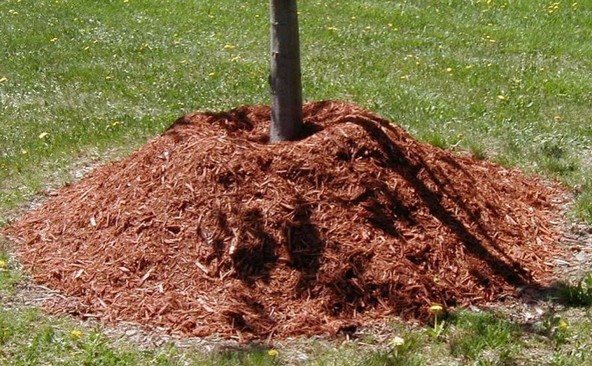

Mulch, firstly, will serve as an ideal environment for earthworms, which will do the work for you to loosen the soil, and secondly, it will inhibit the growth of weeds. It is easier for the apple tree root system to extract moisture, nutrition and oxygen from loose soil, so from time to time you should wield a hoe. Weeds also need to be removed so that they do not deprive the growing seedling of nutrients.
In April, the first top dressing is carried out: five buckets of humus and a half liter of urea are laid out in the trunk circle like mulch. A month later, the leaves are sprayed with an aqueous solution of sodium humate (1 tablespoon per 10 liters of water): 10 liters per tree.
During the flowering period, make the following solution:
- urea - 150 g;
- superphosphate - 250 g;
- potassium sulfate - 200 g;
- stir in 50 liters of water, insist for a week.
Four buckets of solution are applied under each tree - if it rains heavily at this time, the components must be added dry into the trunk circle.
On hot days in summer, foliage is sprayed by adding wood ash to the water.
Disease and pest control
In early spring, preventive treatment for fungal diseases and insect larvae is carried out: trees are sprayed with a solution of urea (700 g per 10 l of water).
The second insect treatment is carried out after the trees have faded. Treatment is carried out with a 10% solution of any insecticide preparation (Actellik, Karbofos). For diseases, preventive treatments are carried out with preparations containing copper.
In autumn, after harvesting, trees are sprayed a third time with a 5% urea solution.Spraying should be done before the leaves fall. The solution will serve as protection from both diseases and parasites.
To fight insects, you can attract birds to the garden - if you have feeders hanging every year, the birds themselves will know where there is food for them. If there is a need for special preparations, the following will help to combat pests: "Benzophosat" and "Karate Zeon" - both preparations can be used during the flowering period, since they are safe for bees.
The Ekrannoe variety is resistant to many diseases, including scab, which often affects fruit trees. But during frequent precipitation, there is still a danger. Prevention is carried out in early spring with Bordeaux liquid, copper oxychloride or copper sulfate. An effective remedy against fungal diseases is the drug "Hom".
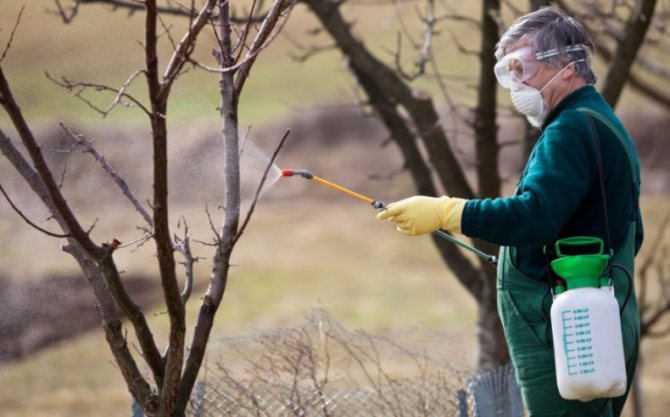

Let's figure out when to prune the apple tree. For the first time, a seedling is pruned after planting, shortening skeletal shoots that are longer than the trunk. According to the rules of pruning, it is carried out either in spring or in autumn. In summer, you cannot cut off, since during this period there is an active circulation of juice inside.
The pruning shears will take thinner branches, if you need to cut strong and thick branches - it is better to take a saw. All instruments must be sharply sharpened, otherwise the edges of the slices will heal for a long time. For processing the cuts, a garden pitch is made. You should know that old dry branches are treated immediately, first smearing with a mixture of copper sulfate and lime (1:10). Young flexible branches are treated with pitch the next day.
After the first pruning, the tree can rest from the procedure for two to three years. Only damaged shoots are removed. Subsequently, the branches are shortened by two-thirds, forming a crown: the branches that interfere with the growth of the main shoots, growing inside the crown and knocking out of shape, are removed.
Agrotechnics
Our hero prefers well-lit areas, an adult tree easily tolerates scattered partial shade. It is unpretentious to soils, but preference should still be given to loose and nutritious loams. He does not like stagnation of water in the roots, therefore, the groundwater level on the site should not be located higher than 1.5 - 2.0 m from the soil surface. It works well on the M9 rootstock, much worse on the M26 and MM106. In the spring, thinning pruning is required, freeing the crown from excessive thickening. Thanks to this, resistance to diseases and pests increases, the fruits become larger and sweeter.
Apple Topaz can be confidently called an outstanding achievement of Czech breeding. The main advantage of the culture is its high scab resistance, thanks to this quality it is used as a donor of resistance to create new varieties. Also, the variety is valued for the high commercial qualities of the fruit, taste characteristics, transportability and keeping quality. With proper agricultural technology, the plant is able to show good frost resistance and high productivity. A small disadvantage is self-infertility, but it can also be easily eliminated by planting a reliable pollinator or grafting it into the crown to Topaz. Currently, there are 2 varieties of this plant - they are Crimson Topaz and Red Topaz.


